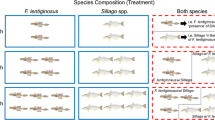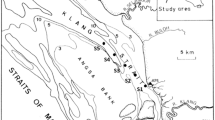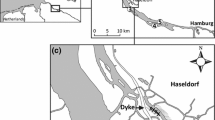Abstract
Changes in the abundance and composition of zooplankton resulting from species introductions may be contributing to a decline in the abundance of planktivorous fish in the San Francisco Estuary (SFE). To examine how changes in the prey assemblage may translate into feeding success of planktivorous fish, we quantified the relative consumption of native and introduced copepods by larval and juvenile delta smelt, Hypomesus transpacificus, and larval striped bass, Morone saxatilis, in laboratory feeding experiments. Larvae ≤20 days post-hatch (dph) of both fish consumed the copepodite stages of ~1 mm calanoid copepods, native Eurytemora affinis and introduced Pseudodiaptomus forbesi, and the smaller (~0.5 mm) introduced cyclopoid copepod, Limnoithona tetraspina, in approximately the same proportion as their abundance in the assemblage. Conversely, prey selection of larvae >20 dph shifted towards the larger calanoid species, E. affinis and P. forbesi. The timing of this shift differed between fish species, occurring earlier in striped bass, and varied between calanoid species, occurring later for P. forbesi than E. affinis. These data suggest that the impacts of introduced prey on planktivorous fish depend not only on the prey being introduced, but also on the resident predators. Additionally, even small differences in size and behavior between native and introduced prey can influence prey selection of planktivorous fish. Changes in prey selection of planktivorous fish resulting from species introductions could directly impact fish recruitment. As a result, species introductions could significantly alter food web function in the SFE and other invaded aquatic ecosystems.



Similar content being viewed by others
References
Ambler JW, Cloern JE, Hutchinson A (1985) Seasonal cycles of zooplankton from San Francisco Bay. Hydrobiologia 129:177–197
Bailey KM, Batty RS (1984) Laboratory study of predation by Aurelia aurita on larvae of cod, flounder, plaice and herring: development and vulnerability to capture. Mar Biol 83:287–291
Barnhisel DR, Harvey HA (1995) Size-specific fish avoidance of the spined crustacean Bythotrephes: field support for laboratory predictions. Can J Fish Aquat Sci 52:768–775
Barnhisel DR, Kerfoot WC (2004) Fitting into food webs: behavioral and functional response of young lake trout (Salvelinus namaycush) to an introduced prey, the spiny cladoceran (Bythotrephes cederstroemi). J Great Lakes Res 30:300–314
Baskerville-Bridges B, Lindberg JC, Doroshov SI (2004) The effect of light intensity, alga concentration, and prey density on the feeding behavior of delta smelt larvae. In: Feyrer F, Brown LR, Brown RL, Orsi JJ (eds) Early Life History of Fishes in the San Francisco Estuary and Watershed. AFS, Bethesda, MD, pp. 219–227
Bennett WA (2005) Critical assessment of the delta smelt population in the San Francisco Estuary, California. San Francisco Estuary Watershed Sci 3:1–71
Bouley P, Kimmerer WJ (2006) Ecology of a highly abundant, introduced cyclopoid copepod in a temperate estuary. Mar Ecol Prog Ser 324:219–228
Bradley CJ, Strickler JR, Buskey EJ, Lenz PH (2013) Swimming and escape behavior in two species of calanoid copepods from nauplius to adult. J Plankton Res 35:49–65
Bremigan MT, Stein RA (1997) Experimental assessment of the influence of zooplankton size and density on gizzard shad recruitment. Trans Am Fish Soc 126:622–637
Buskey EJ (2005) Behavioral characteristics of copepods that affect their suitability as food for larval fishes. In: Lee CS, O’Bryen PJ, Marcus NH (eds) Copepods in Aquaculture. Blackwell Publishing, Carlton, Victoria, pp. 91–105
Buskey EJ, Coulter C, Strom S (1993) Locomotory patterns of microzooplankton: potential effects on food selectivity of larval fish. Bull Mar Sci 53:29–43
Checkley DM Jr (1982) Selective feeding by Atlantic herring (Clupea harengus) larvae on zooplankton in natural assemblages. Mar Ecol Prog Ser 9:245–253
Chesney EJ Jr (1989) Estimating the food requirements of striped bass larvae Morone saxatilis: effects of light, turbidity and turbulence. Mar Ecol Prog Ser 53:191–200
Chesney EJ Jr (2005) Copepods as live prey: a review of factors that influence the feeding success of marine fish larvae. In: Lee CS, O’Bryen PJ, Marcus NH (eds) Copepods in Aquaculture. Blackwell Publishing, Carlton, Victoria, pp. 133–150
Cowan JH Jr, Houde ED (1992) Size-dependent predation on marine fish larvae by ctenophores, Scyphomedusae, and planktivorous fish. Fish Oceanogr 1:113–126
Drost MR (1987) Relation between aiming and catch success in larval fishes. Can J Fish Aquat Sci 44:304–315
Eggers DM (1977) The nature of prey selection by planktivorous fish. Ecology 58:46–59
Eldridge MB, Whipple JA, Eng D, Bowers MJ, Jarvis BM (1981) Effects of food and feeding factors on laboratory-reared striped bass larvae. Trans Am Fish Soc 110:111–120
Eldridge MB, Whipple JA, Bowers MJ (1982) Bioenergetics and growth of striped bass, Morone saxatilis, embryos and larvae. Fish Bull 80:461–474
Feyrer F, Herbold B, Matern SA, Moyle PB (2003) Dietary shifts in a stressed fish assemblage: Consequences of a bivalve invasion in the San Francisco Estuary. Environ Biol Fish 67:277–288
Fields DM (2000) Characteristics of the high frequency escape reactions of Oithona sp. Mar Freshw Behav Physiol 34:21–35
Fields DM (2010) Orientation affects the sensitivity of Acartia tonsa to fluid mechanical signals. Mar Biol 157:505–514
Gerritsen J, Strickler JR (1977) Encounter probabilities and community structure in zooplankton: a mathematical model. J Fish Res Board Can 34:73–82
Gill AB (2003) The dynamics of prey choice in fish: the importance of prey size and satiation. J Fish Biol 63:105–116
Gorokhova E, Hansson S, Hoglander H, Andersen CM (2005) Stable isotopes show food web changes after invasion by the predatory cladoceran Cercopagis pengoi in a Baltic Sea bay. Oecologia 143:251–259
Govoni JJ, Ortner PB, Al-Yamani F, Hill LC (1986) Selective feeding of spot, Leiostomus xanthurus, and Atlantic croaker, Micropogonias undulates, larvae in the northern Gulf of Mexico. Mar Ecol Prog Ser 28:175–183
Hammock BG, Hobbs JA, Slater SB, Acuña S, Teh SJ (2015) Contaminant and food limitation stress in an endangered estuarine fish. Sci Total Environ 532:316–326
Holling CS (1966) The functional response of invertebrate predators to prey density. Mem Entomol Soc Can 48:1–86
Houde ED (1978) Critical food concentrations for larvae of three species of subtropical marine fishes. Bull Mar Sci 28:395–411
Houde ED, Schekter RC (1980) Feeding by marine fish larvae: developmental and functional responses. Environ Biol Fish 5:315–334
Hunt von Herbing I, Gallager SM (2000) Foraging behavior in early Atlantic cod larvae (Gadus morhua) feeding on a protozoan (Balanion sp.) and a copepod nauplius (Pseudodiaptomus sp.). Mar Biol 136:591–602
Hunter JR (1981) Feeding ecology and predation of marine fish larvae. In: Lasker R (ed) Marine Fish Larvae: Morphology, Ecology, and Relation to Fisheries. University of Washington Press, Seattle, WA, pp. 33–77
Kane J (1984) The feeding habits of co-occurring cod and haddock larvae from Georges Bank. Mar Ecol Prog Ser 16:9–20
Kimmerer WJ, Orsi JJ (1996) Changes in the zooplankton of the San Francisco Estuary since the introduction of the clam Potamocorbula amurensis. In: Hollibaugh JT (ed) San Francisco Bay: The Ecosystem. AAAS, San Francisco, CA, pp. 403–424
Kimmerer WJ, Cowan JH Jr, Miller LW, Rose KA (2000) Analysis of an estuarine striped bass (Morone saxatalis) population: influence of density-dependent mortality between metamorphosis and recruitment. Can J Fish Aquat Sci 57:478–486
Kimmerer WJ, Cowan JH Jr, Miller LW, Rose KA (2001) Analysis of an estuarine striped bass population: effects of environmental conditions during early life. Estuaries 24:557–575
Kimmerer WJ, Parker AE, Lidström U, Carpenter EJ (2012) Short-term and interannual variability in primary production in the low-salinity zone of the San Francisco Estuary. Estuar Coasts 35:913–929
Kiørboe T, Munk P (1986) Feeding and growth of larval herring, Clupea harengus, in relation to density of copepod nauplii. Environ Biol Fish 17:133–139
Lee CE (2000) Global phylogeography of a cryptic copepod species complex and reproductive isolation between genetically proximate “populations”. Evolution 54:2014–2027
Lehtiniemi M, Engstrom-Ost J, Viitasalo M (2005) Turbidity decreases anti-predator behaviour in pike larvae, Esox lucius. Environ Biol Fish 73:1–8
Limburg KE, Pace ML, Fischer D, Arend KK (1997) Consumption, selectivity, and use of zooplankton by larval striped bass and white perch in a seasonally pulsed estuary. Trans Am Fish Soc 126:607–621
Lindberg JC, Tigan G, Ellison L, Rettinghouse T, Nagel MM, Fisch KM (2013) Aquaculture methods for a genetically managed population of endangered delta smelt. N Am J Aquac 75:186–196
Mac Nally R, Thomson JR, Kimmerer WJ, Feyrer F, Newman KB, Sih A, Bennett WA, Brown L, Fleishman E, Culberson SD, Castillo G (2010) Analysis of pelagic species decline in the upper San Francisco estuary using multivariate autoregressive modeling (MAR. Ecol Appl 20:1417–1430
MacKenzie BR, Leggett WC, Peters RH (1990) Estimating larval fish ingestion rates: can laboratory derived values be reliably extrapolated to the wild? Mar Ecol Prog Ser 67(3):209–225
Mittelbach GG, Persson L (1998) The ontogeny of piscivory and its ecological consequences. Can J Fish Aquat Sci 55:1454–1465
Moyle PB, Herbold B, Stevens DE, Miller LW (1992) Life history and status of delta smelt in the Sacramento-San Joaquin estuary, California. Trans Am Fish Soc 121:67–77
Nobriga M (1998) Evidence of food limitation in larval delta smelt. IEP. Newsletter 11:20–24
Nobriga M (2002) Larval delta smelt diet composition and feeding incidence: environmental and ontogenetic influences. Calif Fish Game 88:149–164
Nunn AD, Harvey JP, Cowx IG (2007) The food and feeding relationship of larval and 0+ year juvenile fishes in lowland rivers and connected waterbodies. II. Prey selection and the influence of gape. J Fish Biol 70:743–757
O’Brien WJ (1979) The predator-prey interaction of planktivorous fish and zooplankton. Am Sci 67:572–581
Orsi JJ, Mecum WL (1986) Zooplankton distribution and abundance in the Sacramento-San Joaquin Delta in relation to certain environmental factors. Estuaries 9:326–339
Orsi JJ, Ohtsuka S (1999) Introduction of the Asian copepods Acartiella sinensis, Tortanus dextrilobatus (Copepoda: Calanoida), and Limnoithona tetraspina (Copepoda: Cyclopoida) to the San Francisco estuary, California, USA. Plankton Biol. Ecol 46:128–131
Orsi JJ, Walter TC (1991) Pseudodiaptomus forbesi and P. marinus (Copepoda: Calanoida), the latest copepod immigrants to California’s Sacramento-San Joaquin Estuary. Bull Plankton Soc Japan Special Volume 553–562
Ostrach DJ, Low-Marchelli JM, Eder KJ, Whiteman SJ, Zinkl JG (2008) Maternal transfer of xenobiotics and effects on larval striped bass in the San Francisco estuary. Proc Natl Acad Sci U S A 105:19354–19359
Parker Stetter SLP, Witzel LD, Rudstam LG, Einhouse DW, Mills EL (2005) Energetic consequences of diet shifts in Lake Erie rainbow smelt (Osmerus mordax. Can J Fish Aquat Sci 62:145–152
Pearre S Jr (1982) Estimating prey preference by predators: uses of various indices, and a proposal of another based on χ2. Can J Fish Aquat Sci 39:914–923
Pepin P, Penney RW (1997) Patterns of prey size and taxonomic composition in larval fish: are there general size-dependent models? J Fish Biol 51(Supplement A):84–100
Peterson WT, Ausubel SJ (1984) Diets and selective feeding by larvae of Atlantic mackerel Scromber scrombrus on zooplankton. Mar Ecol Prog Ser 17:65–75
R Development Core Team (2014) R: A Language and Environment for Statistical Computing. R Foundation for Statistical Computing, Vienna
Rajasilta M, Vuorinen I (1983) A field study of prey selection in planktivorous fish larvae. Oecologia 59:65–68
Schael DM, Rudstam LG, Post JR (1991) Gape limitation and prey selection in larval yellow perch (Perca flavescens), freshwater drum (Aplodinotus grunniens), and black crappie (Pomoxis nigromaculatus). Can J Fish Aquat Sci 48:1919–1925
Skajaa K, Ferno A, Folkvord A (2004) Ontogenetic- and condition-related effects of starvation on responsiveness in herring larvae (Clupea harengus L.) during repeated attacks by a model predator. J Exp Mar Biol Ecol 312:253–269
Slater SB, Baxter RD (2014) Diet, prey selection, and body condition of age-0 delta smelt, Hypomesus transpacificus, in the Upper San Francisco Estuary. San Francisco Estuary Watershed Sci 12:1–24
Sommer T, Armor C, Baxter R, Breuer R, Brown L, Chotkowski M, Culberson S, Feyrer F, Gingras M, Herbold B, Kimmerer W, Mueller-Solger A, Nobriga M, Souza K (2007) The collapse of pelagic fishes in the upper San Francisco estuary. Fisheries 32:270–277
Stevens DE, Kohlhorst DW, Miller LW, Kelley DW (1985) The decline of striped bass in the Sacramento-San Joaquin estuary, California. Trans Am Fish Soc 114:12–30
Storch AJ, Schulz KL, Caceres CE, Smyntek PM, Dettmers JM, Teece MA (2007) Consumption of two exotic zooplankton by alewife (Alosa pseudoharengus) and rainbow smelt (Osmerus mordax) in three Laurentian Great Lakes. Can J Fish Aquat Sci 64:1314–1328
Tukey JW (1977) Exploratory Data Analysis. Addison-Wesley, Reading
Winder M, Jassby A (2011) Shifts in zooplankton community structure: implications for food web processes in the upper San Francisco estuary. Estuar Coasts 34:675–690
Zaret T, Suffern J (1976) Vertical migration in zooplankton as a predator avoidance mechanism. Limnol Oceanogr 21:804–813
Acknowledgments
We thank Joan Lindberg for help with the experimental design. We also thank Lauren Damon, Luke Ellison, John Nunes, Theresa Rettinghouse, and Dagmara Saini for maintaining the delta smelt cultures, and Clarence Chin, Eric Durieux, Patrick Fitzgerald, Rose Hoang, Eric Shih, Tony Vaught, and George Whitman for maintaining the striped bass cultures. We are also thankful for Sean Rohtla, who watched and re-watched hours of videos, and Alison Gould for measuring the L. tetrapsina nauplii. We are grateful to Anne Slaughter and two anonymous reviewers for their helpful comments regarding the manuscript. This research was supported by the CALFED Science Fellows Program administered by California Sea Grant (R/SF-15) in cooperation with the California Bay-Delta Authority for research funded under the California Bay-Delta Authority (Agreement No. U-04-SC-005). Additional support was provided by the Interagency Ecological Program’s work plan on the Pelagic Organism Decline under the California Department of Water Resources to Wim Kimmerer (Contract No. 4600007494), David Ostrach (Contract No. 4600004664), and Joan Lindberg and Bradd Baskerville-Bridges (Contract No. 4600007604).
Author information
Authors and Affiliations
Corresponding author
Rights and permissions
About this article
Cite this article
Sullivan, L.J., Ignoffo, T.R., Baskerville-Bridges, B. et al. Prey selection of larval and juvenile planktivorous fish: impacts of introduced prey. Environ Biol Fish 99, 633–646 (2016). https://doi.org/10.1007/s10641-016-0505-x
Received:
Accepted:
Published:
Issue Date:
DOI: https://doi.org/10.1007/s10641-016-0505-x




